50% of the aparments in a certain building have windows and hardwood floors. 25% of the apartments without windows have hardwood floors. If 40% of the apartments do not have hardwood floors, what percent of the apartments with windows have hardwood floors?
a) 40%
b) 10%
c ) 16 2/3 %
d) 50%
e) 83 1/3 %
Apartments
This topic has expert replies
- goyalsau
- Legendary Member
- Posts: 866
- Joined: Mon Aug 02, 2010 6:46 pm
- Location: Gwalior, India
- Thanked: 31 times
Saurabh Goyal
[email protected]
-------------------------
EveryBody Wants to Win But Nobody wants to prepare for Win.
[email protected]
-------------------------
EveryBody Wants to Win But Nobody wants to prepare for Win.
-
krazy800
- Master | Next Rank: 500 Posts
- Posts: 136
- Joined: Sun Sep 28, 2008 8:20 pm
- Location: fssf
- Thanked: 17 times
This problem has already been solved. Check out this link.
https://www.beatthegmat.com/how-to-solve ... 28990.html
https://www.beatthegmat.com/how-to-solve ... 28990.html
Aiming High
- GMATGuruNY
- GMAT Instructor
- Posts: 15539
- Joined: Tue May 25, 2010 12:04 pm
- Location: New York, NY
- Thanked: 13060 times
- Followed by:1906 members
- GMAT Score:790
Whenever we have groups (in this case, apartments with windows and those without) that are being divided into smaller groups (in this case, apartments with hardwood floors and those without), we can use a group grid to organize the data.goyalsau wrote:50% of the aparments in a certain building have windows and hardwood floors. 25% of the apartments without windows have hardwood floors. If 40% of the apartments do not have hardwood floors, what percent of the apartments with windows have hardwood floors?
a) 40%
b) 10%
c ) 16 2/3 %
d) 50%
e) 83 1/3 %
Here's what the grid looks like (W = windows, NW = no windows, H = hardwood floors, NH = no hardwood floors):
_______________W______NW_______Total
H:
NH:
total:
In the grid above, every row has to add up to the total, as does every column. Looking at the top row, hardwood floors with windows + hardwood floors with no windows = total hardwood floors. Looking at the left-most column, windows with hardwood floors + windows with no hardwood floors = total windows.
Now let's fill in the data step by step. Whenever we have get 2 entries in a row or a column, we can determine the remaining entry in that row or column.
Let's plug in 100 for the total number of apartments:
_______________W______NW_______Total
H:
NH:
total:_____________________________100
50% have windows and hardwood floors:
_______________W______NW_______Total
H:_____________50
NH:
total:______________________________100
40% of the apartments do not have hardwood floors:
_______________W______NW_______Total
H:_____________50______10__________60
NH:_______________________________40
total:______________________________100
25% of the apartments without windows have hardwood floors. Since 10 = .25*40, we must have 40 total apartments with no windows, and the rest of the grid can be completed:
_______________W______NW_______Total
H:_____________50______10_________60
NH:____________10______30_________40
total:___________60______40_________100
Notice that everything adds up horizontally and vertically. Neat!
Total windows = 60
Windows with hardwood floors = 50
50/60*100 = 83 1/3%
The correct answer is E.
Private tutor exclusively for the GMAT and GRE, with over 20 years of experience.
Followed here and elsewhere by over 1900 test-takers.
I have worked with students based in the US, Australia, Taiwan, China, Tajikistan, Kuwait, Saudi Arabia -- a long list of countries.
My students have been admitted to HBS, CBS, Tuck, Yale, Stern, Fuqua -- a long list of top programs.
As a tutor, I don't simply teach you how I would approach problems.
I unlock the best way for YOU to solve problems.
For more information, please email me (Mitch Hunt) at [email protected].
Student Review #1
Student Review #2
Student Review #3
Followed here and elsewhere by over 1900 test-takers.
I have worked with students based in the US, Australia, Taiwan, China, Tajikistan, Kuwait, Saudi Arabia -- a long list of countries.
My students have been admitted to HBS, CBS, Tuck, Yale, Stern, Fuqua -- a long list of top programs.
As a tutor, I don't simply teach you how I would approach problems.
I unlock the best way for YOU to solve problems.
For more information, please email me (Mitch Hunt) at [email protected].
Student Review #1
Student Review #2
Student Review #3
- goyalsau
- Legendary Member
- Posts: 866
- Joined: Mon Aug 02, 2010 6:46 pm
- Location: Gwalior, India
- Thanked: 31 times
Thanks Guru
I was doing it the same way but i am not able to place windows and hardwood floors in the table properly that's why not able to figure out the exact combination.
Can you suggest me some ways, As i know in this type of problems its best to approach with table but placing of items like windows and hardwood are very important as i was known that i have to it with this approach but still not to solve it .
I was doing it the same way but i am not able to place windows and hardwood floors in the table properly that's why not able to figure out the exact combination.
Can you suggest me some ways, As i know in this type of problems its best to approach with table but placing of items like windows and hardwood are very important as i was known that i have to it with this approach but still not to solve it .
Saurabh Goyal
[email protected]
-------------------------
EveryBody Wants to Win But Nobody wants to prepare for Win.
[email protected]
-------------------------
EveryBody Wants to Win But Nobody wants to prepare for Win.
-
GMATMadeEasy
- Legendary Member
- Posts: 768
- Joined: Mon Nov 30, 2009 3:46 am
- Thanked: 21 times
- Followed by:7 members
Thanks GMARGuruNY . Your solution helps to understand the problem clearly and how to solve it.
An important question : How could we distinguish problems when to use grid and when not to use ? (I am aware that when two groups and two attributes , use the grid approach.) and you also explained when two groups are divided into two subgroups.But for the question below, how to figure which approach to apply ?
Of the students who eat in a certain cafetaria, each student either dislikes or likes lima beans and each student either likes or dislikes brussels sprouts. Of these students, 2/3 like lima beans; and of those who dislike lima beans, 3/5 also like brussels sprouts. How many of the students like brussels sprouts but dislike lima beans?
1. 120 students eat in cafeteria
2. 40 of the students like lima beans.
Thanks for your valuable feedback.
An important question : How could we distinguish problems when to use grid and when not to use ? (I am aware that when two groups and two attributes , use the grid approach.) and you also explained when two groups are divided into two subgroups.But for the question below, how to figure which approach to apply ?
Of the students who eat in a certain cafetaria, each student either dislikes or likes lima beans and each student either likes or dislikes brussels sprouts. Of these students, 2/3 like lima beans; and of those who dislike lima beans, 3/5 also like brussels sprouts. How many of the students like brussels sprouts but dislike lima beans?
1. 120 students eat in cafeteria
2. 40 of the students like lima beans.
Thanks for your valuable feedback.
- goyalsau
- Legendary Member
- Posts: 866
- Joined: Mon Aug 02, 2010 6:46 pm
- Location: Gwalior, India
- Thanked: 31 times
Is it D.GMATMadeEasy wrote:Thanks GMARGuruNY . Your solution helps to understand the problem clearly and how to solve it.
An important question : How could we distinguish problems when to use grid and when not to use ? (I am aware that when two groups and two attributes , use the grid approach.) and you also explained when two groups are divided into two subgroups.But for the question below, how to figure which approach to apply ?
Of the students who eat in a certain cafetaria, each student either dislikes or likes lima beans and each student either likes or dislikes brussels sprouts. Of these students, 2/3 like lima beans; and of those who dislike lima beans, 3/5 also like brussels sprouts. How many of the students like brussels sprouts but dislike lima beans?
1. 120 students eat in cafeteria
2. 40 of the students like lima beans.
Thanks for your valuable feedback.
I don't know whether i am right or wrong,
But awesome question....
and please post the OA so if i am right, I can share my logic and if i am wrong, will definitely ask others for solution.
Saurabh Goyal
[email protected]
-------------------------
EveryBody Wants to Win But Nobody wants to prepare for Win.
[email protected]
-------------------------
EveryBody Wants to Win But Nobody wants to prepare for Win.
-
GMATMadeEasy
- Legendary Member
- Posts: 768
- Joined: Mon Nov 30, 2009 3:46 am
- Thanked: 21 times
- Followed by:7 members
- goyalsau
- Legendary Member
- Posts: 866
- Joined: Mon Aug 02, 2010 6:46 pm
- Location: Gwalior, India
- Thanked: 31 times
I did this question with the help of vein Diagram,GMATMadeEasy wrote:Thanks GMARGuruNY . Your solution helps to understand the problem clearly and how to solve it.
A
Of the students who eat in a certain cafetaria, each student either dislikes or likes lima beans and each student either likes or dislikes brussels sprouts. Of these students, 2/3 like lima beans;and of those who dislike lima beans, 3/5 also like brussels sprouts.
How many of the students like brussels sprouts but dislike lima beans?
1. 120 students eat in cafeteria
2. 40 of the students like lima beans.
Thanks for your valuable feedback.
there are two type of eaters one is L and another one is S .
and its compulsory for every student to like or dislike ... i.e is a very big hint in this question.
Lets assume there are 30 students in the cafeteria , this means we will have 60 results in all
30 results for eater L and 30 for eater 30
Now it say 2/3 like L Means out of 30 students 20 like L and 10 dis like L ..
As per the rule everybody has to like to dislike..
Then it says and of those who dislike L , 3/5 also like brussels sprouts.
By this statement we know that 3/5 of 10 is 6,
Now we know 6 students like B.
This is the question that we need to answer.
How many of the students like brussels sprouts but dislike lima beans?
there are 6 students.
Now important note.
We also know those 4 students who dislike L and don't like B as well .
That group dislike both,
But we don't have any information about those 20 students who like L. may all dislike B or like B. WE don't know and it does not matter to us as well..
Because the question only ask about those students who dislike L and like B.
We don't any thing about the rest of 24 students view on the eater B.
I assumed 40 as total number of students we you have the number you can easily give the answer.
in 2 statement its gives us no. of those people who like L and we know they are in all 2/3 of all so total no. of students must be 60.
I think i explained OK OK.
But still if you have some doubt I will try again..
Saurabh Goyal
[email protected]
-------------------------
EveryBody Wants to Win But Nobody wants to prepare for Win.
[email protected]
-------------------------
EveryBody Wants to Win But Nobody wants to prepare for Win.
- GMATGuruNY
- GMAT Instructor
- Posts: 15539
- Joined: Tue May 25, 2010 12:04 pm
- Location: New York, NY
- Thanked: 13060 times
- Followed by:1906 members
- GMAT Score:790
This is a DS question. We are being asked only whether there is sufficient information to determine the number of students who like brussels but dislike limas. We could use the group grid, but I don't think that it's needed.GMATMadeEasy wrote:Thanks GMARGuruNY . Your solution helps to understand the problem clearly and how to solve it.
An important question : How could we distinguish problems when to use grid and when not to use ? (I am aware that when two groups and two attributes , use the grid approach.) and you also explained when two groups are divided into two subgroups.But for the question below, how to figure which approach to apply ?
Of the students who eat in a certain cafetaria, each student either dislikes or likes lima beans and each student either likes or dislikes brussels sprouts. Of these students, 2/3 like lima beans; and of those who dislike lima beans, 3/5 also like brussels sprouts. How many of the students like brussels sprouts but dislike lima beans?
1. 120 students eat in cafeteria
2. 40 of the students like lima beans.
Thanks for your valuable feedback.
Let S = students.
Like limas = (2/3)S
So dislike limas = (1/3)S
Dislike limas but like brussels = (3/5)(1/3)S
To answer the question, we need to know either the value of S or the number who like/dislike limas. Hence each statement is sufficient. The correct answer is D.
Private tutor exclusively for the GMAT and GRE, with over 20 years of experience.
Followed here and elsewhere by over 1900 test-takers.
I have worked with students based in the US, Australia, Taiwan, China, Tajikistan, Kuwait, Saudi Arabia -- a long list of countries.
My students have been admitted to HBS, CBS, Tuck, Yale, Stern, Fuqua -- a long list of top programs.
As a tutor, I don't simply teach you how I would approach problems.
I unlock the best way for YOU to solve problems.
For more information, please email me (Mitch Hunt) at [email protected].
Student Review #1
Student Review #2
Student Review #3
Followed here and elsewhere by over 1900 test-takers.
I have worked with students based in the US, Australia, Taiwan, China, Tajikistan, Kuwait, Saudi Arabia -- a long list of countries.
My students have been admitted to HBS, CBS, Tuck, Yale, Stern, Fuqua -- a long list of top programs.
As a tutor, I don't simply teach you how I would approach problems.
I unlock the best way for YOU to solve problems.
For more information, please email me (Mitch Hunt) at [email protected].
Student Review #1
Student Review #2
Student Review #3
-
GMATMadeEasy
- Legendary Member
- Posts: 768
- Joined: Mon Nov 30, 2009 3:46 am
- Thanked: 21 times
- Followed by:7 members
@ GMATGuruNY : Thank you. I wanted to apply your method on the question , but could not. Could you just lead to build the grid with values, I get ,helplessly, confused while attempting this particular one using grid.
Your explanations do boost confidence .
.
Your explanations do boost confidence
GMAT/MBA Expert
- Brent@GMATPrepNow
- GMAT Instructor
- Posts: 16207
- Joined: Mon Dec 08, 2008 6:26 pm
- Location: Vancouver, BC
- Thanked: 5254 times
- Followed by:1268 members
- GMAT Score:770
Hi GMATMadeEasy. Here's the grid approach (aka Double Matrix Method):GMATMadeEasy wrote:Could you just lead to build the grid with values, I get ,helplessly, confused while attempting this particular one using grid.
We can use the Double Matrix Method to solve this question. This technique can be used for most questions featuring a population in which each member has two characteristics associated with it.Of the students who eat in a certain cafeteria, each student either likes or dislikes lima beans and each student either like or dislikes Brussels sprouts. Of theses students, 2/3 dislike lima beans; and of those who dislike lima beans, 3/5 also dislike Brussels sprouts. How many of the students like Brussels sprouts but dislike lima beans?
(1) 120 students eat in the cafeteria
(2) 40 of the students like lima beans.
Here, we have a population of students, and the two characteristics are:
- like Brussels sprouts or dislike Brussels sprouts
- like lima beans or dislike lima beans
So, we can set up our diagram as follows:
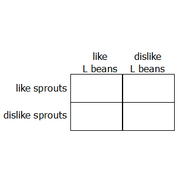
Target question: How many of the students like Brussels sprouts but dislike lima beans?
Let's place a STAR in the box representing those students who like Brussels sprouts but dislike lima beans.
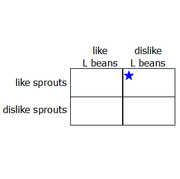
Since we don't know the TOTAL NUMBER of students, let's let x represent the total student population. So, we'll add that to our diagram as well.
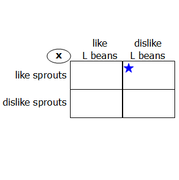
Given: 2/3 dislike lima beans
So, (2/3)x = total number of students who dislike lima beans
This means the other 1/3 LIKE lima beans. In other words, (1/3)x = total number of students who LIKE lima beans.
We'll add that to the diagram:
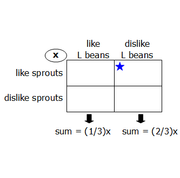
Given: Of those who dislike lima beans, 3/5 also dislike Brussels sprouts
If (2/3)x = total number of students who dislike lima beans, then (3/5)(2/3)x = total number of students who dislike lima beans AND dislike Brussels sprouts.
(3/5)(2/3)x simplifies to (2/5)x, so we'll add that to our diagram:
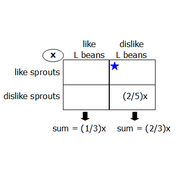
Finally, since the two boxes in the right-hand column must add to (2/3)x, we know that the top-right box must = (4/15)x [since (2/3)x - (2/5)x = (4/15)x]
So, we can add that to the diagram:
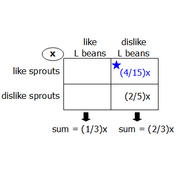
Great! We're now ready to examine the statements.
Statement 1: 120 students eat in the cafeteria
In other words, x = 120
Plug x = 120 into the top-right box to get: (4/15)(120) = 32
So, there are 32 students who like Brussels sprouts but dislike lima beans.
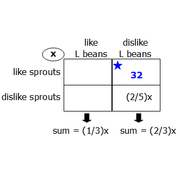
Since we can answer the target question with certainty, statement 1 is SUFFICIENT
Statement 2: 40 of the students like lima beans.
The left-hand column represents students who like lima beans.
In total, (1/3)x = total number of students who LIKE lima beans.
So, statement 2 is telling us that (1/3)x = 40
We can solve the equation to conclude that x = 120
Once we know the value of x, we can determine the number of students who like Brussels sprouts but dislike lima beans (we already did so in statement 1)
Since we can answer the target question with certainty, statement 2 is SUFFICIENT
Answer = D
------------------------------
To learn more about the Double Matrix Method, watch our video: https://www.gmatprepnow.com/module/gmat- ... ems?id=919
Once you're familiar with this technique, you can attempt these additional practice questions:
Easy Problem Solving questions
- https://www.beatthegmat.com/the-aam-aadm ... 72242.html
- https://www.beatthegmat.com/finance-majo ... 67425.html
Medium Problem Solving questions
- https://www.beatthegmat.com/probability- ... 73360.html
- https://www.beatthegmat.com/posted-speed ... 72374.html
- https://www.beatthegmat.com/motel-t271938.html
- https://www.beatthegmat.com/of-the-appli ... 70255.html
- https://www.beatthegmat.com/opening-nigh ... 64869.html
- https://www.beatthegmat.com/ds-french-ja ... 22297.html
Difficult Problem Solving questions
- https://www.beatthegmat.com/ratio-problem-t268339.html
- https://www.beatthegmat.com/overlapping- ... 65223.html
- https://www.beatthegmat.com/fractions-t264254.html
- https://www.beatthegmat.com/overlapping- ... 64092.html
- https://www.beatthegmat.com/mba/2011/05/ ... question-2
Easy Data Sufficiency questions
- https://www.beatthegmat.com/for-what-per ... 70596.html
- https://www.beatthegmat.com/ds-quest-t187706.html
Medium Data Sufficiency questions
- https://www.beatthegmat.com/sets-matrix-ds-t271914.html
- https://www.beatthegmat.com/each-of-peop ... 71375.html
- https://www.beatthegmat.com/a-manufacturer-t270331.html
- https://www.beatthegmat.com/in-costume-f ... 69355.html
- https://www.beatthegmat.com/mba/2011/05/ ... question-1
Difficult Data Sufficiency questions
- https://www.beatthegmat.com/double-set-m ... 71423.html
- https://www.beatthegmat.com/sets-t269449.html
- https://www.beatthegmat.com/mba/2011/05/ ... question-3
Cheers,
Brent
-
Matt@VeritasPrep
- GMAT Instructor
- Posts: 2630
- Joined: Wed Sep 12, 2012 3:32 pm
- Location: East Bay all the way
- Thanked: 625 times
- Followed by:119 members
- GMAT Score:780
Another nice trick on Brent's last Q: the two statements are IDENTICAL, so we can eliminate choices A, B, and C right away! That leaves us with D or E, and from there we can pick the statement we find easier to plug in.
Personally, I'd do the last one algebraically. We know that (2/3) dislike lima beans, and of those, (2/5) like brussels sprouts. (How anyone can like these is beyond me: I grew up next to a brussels sprouts farm and am still recovering, but be that as it may ...)
Anyway, we now know that we seek (2/3) * (2/5) => 4/15 of the total. From there, S1 is clearly sufficient, and since S2 is the same as S1, we're done!
Personally, I'd do the last one algebraically. We know that (2/3) dislike lima beans, and of those, (2/5) like brussels sprouts. (How anyone can like these is beyond me: I grew up next to a brussels sprouts farm and am still recovering, but be that as it may ...)
Anyway, we now know that we seek (2/3) * (2/5) => 4/15 of the total. From there, S1 is clearly sufficient, and since S2 is the same as S1, we're done!



















